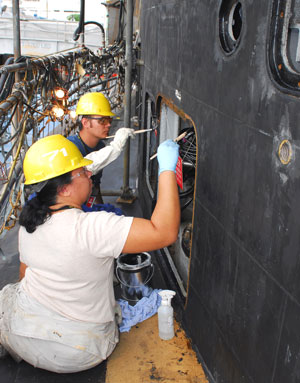
For the last 10 years, Honolulu Community College has partnered with the Pearl Harbor Naval Shipyard in training apprentices to become journeyman mechanics for the Pearl Harbor Naval Shipyard.
The Pearl Harbor Apprenticeship Program is a four-year, work-study program that provides opportunities for selected trainees to work alongside journeymen and receive trade theory training while working toward an associate in applied science degree from Honolulu Community College. After earning their degree during the first two years, the trainees continue for two years as apprentices until they graduate as journeyman mechanics.
Recruitment for the 2013 class will take place at the annual Pearl Harbor Naval Shipyard and Intermediate Maintenance Facility Apprentice Career Fair on Saturday, April 14, 8 a.m.–noon at Honolulu Community College’s courtyard between Building 5 and the cafeteria.
Approximately 100 spots are open each year for the program. The average starting pay is $19 an hour. At the end of four years, apprentice program graduates will earn $28 or more an hour.
Candidate requirements
- Be a United States citizen
- Be 18 years of age by January 2013
- Be a high school graduate or have a GED
- Pass a physical exam, a security clearance and a Work Readiness Test
Applications for the program will be available on the federal government’s official jobs website and additional information can be found on the Pearl Harbor Naval Shipyard and Intermediate Maintenance Facility website. It is highly recommended that applicants attend the career fair to learn more about the program and the positions available.
Through the Pearl Harbor Apprenticeship Program, Honolulu Community College has graduated more than 2,000 student apprentices who help carry out the Pearl Harbor Naval Shipyard’s mission of repairing and maintaining U.S. Navy ships and submarines.

